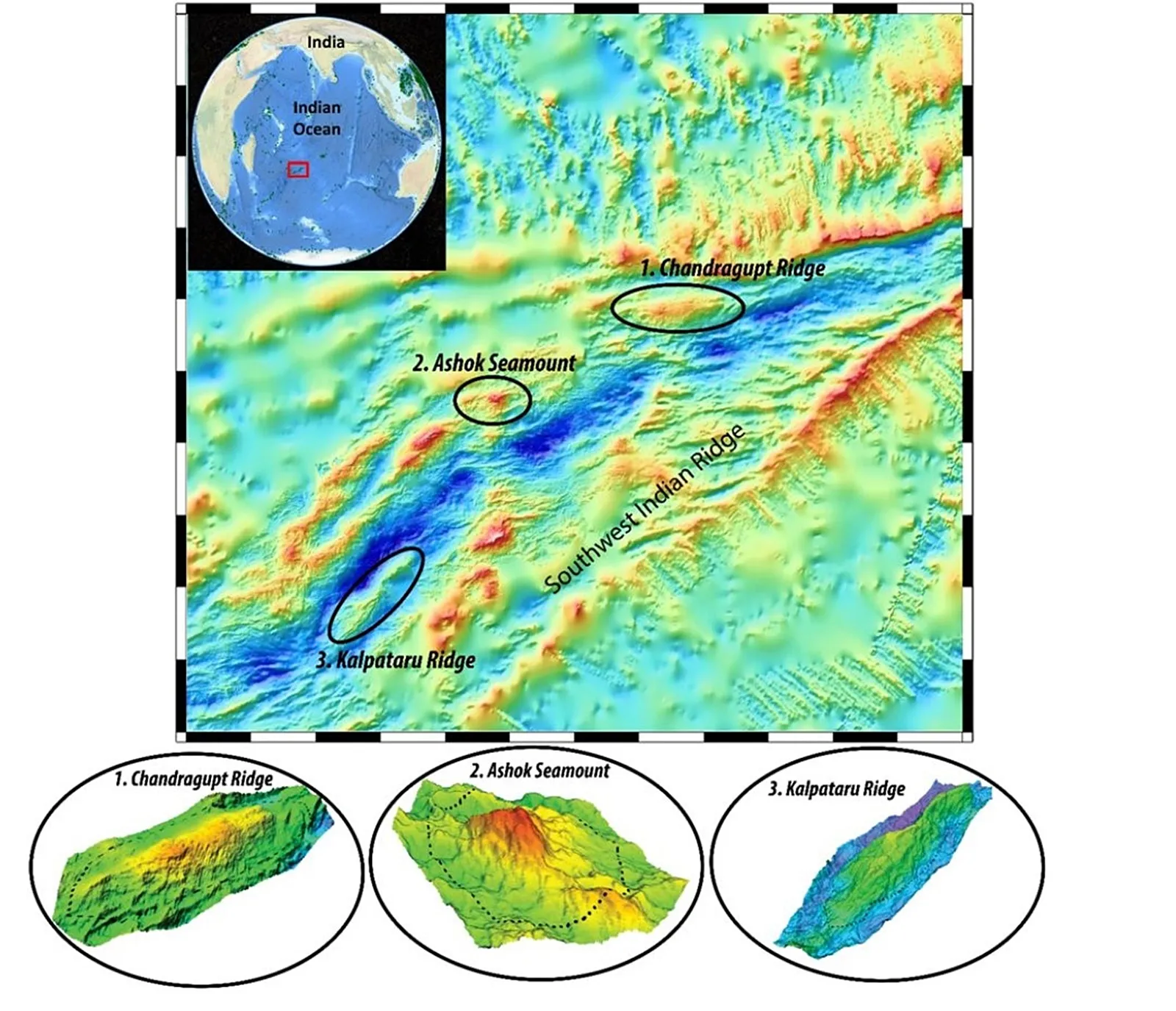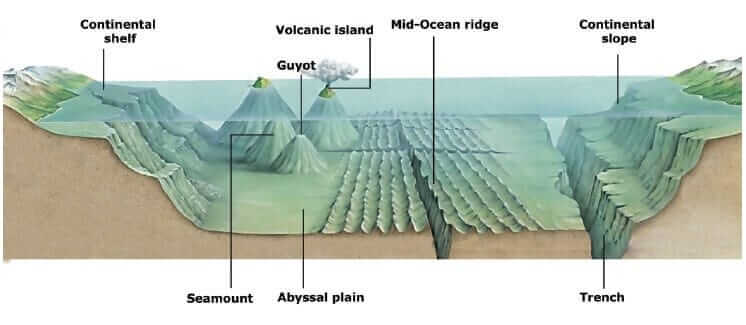Underwater Structures in the Indian Ocean | 10 Aug 2024
For Prelims: Deep Sea Oceans, Relief, Structures and Types, Mauryan Empire.
For Mains: Different Underwater Structures/Relief on the Ocean Floor
Why in News?
Recently, three underwater structures in the Indian Ocean were named as Ashoka, Chandragupt, and Kalpataru, which reflect India's growing influence in marine science and its commitment to exploring and understanding the Indian Ocean.
- This naming was proposed by India and approved by the International Hydrographic Organisation (IHO) and UNESCO’s Intergovernmental Oceanographic Commission (IOC).
International Hydrographic Organisation (IHO)
- It is an intergovernmental consultative and technical body established in 1921 to enhance navigation safety and protect the marine environment.
- India is a member of the IHO.
- Objectives:
- Coordinating the activities of national hydrographic offices.
- Achieving the highest possible uniformity in nautical charts and documents.
- Promoting the adoption of reliable and efficient methods for conducting and utilising hydrographic surveys.
- Advancing the sciences of hydrography and the techniques used in descriptive oceanography.
UNESCO’s Intergovernmental Oceanographic Commission (IOC)
- It promotes international cooperation in marine sciences, capacity development, ocean observations and services, ocean science, tsunami warning, and ocean literacy.
- It has 150 member states, and India has been a member since 1946.
- The IOC's work contributes to UNESCO's mission to promote the advancement of science and its applications for economic and social progress.
- The IOC is coordinating the United Nations Decade of Ocean Science for Sustainable Development 2021-2030, also known as the "Ocean Decade."
What are the Key Facts About the Underwater Structures?
- Background and Significance: The discoveries of these underwater structures are part of the Indian Southern Ocean Research Programme, initiated in 2004, with the National Centre for Polar and Ocean Research (NCPOR) as the nodal agency.
- The program aims to study various aspects including bio-geochemistry, biodiversity, and hydrodynamics.
- Total Structures:
- Seven structures, including the recently added ones in the Indian Ocean, are now named primarily after Indian scientists or based on names proposed by India.
- Previously Named Structures:
- Raman Ridge (accepted in 1992): It was discovered in 1951 by a US oil vessel. It was named after Physicist and Nobel Laureate Sir CV Raman.
- Panikkar Seamount (accepted in 1993): It was discovered in 1992 by India research vessel Sagar Kanya. It is named after NK Panikkar, a renowned oceanographer.
- Sagar Kanya Seamount (accepted in 1991): For its successful 22nd cruise in 1986 leading to its discovery, a seamount was named after the research vessel Sagar Kanya itself.
- DN Wadia Guyot: It was named after geologist DN Wadia in 1993 when an underwater volcanic mountain (guyot), was discovered in 1992 by Sagar Kanya.
- Recently Named Structures:
- Ashoka Seamount: It was discovered in 2012. It is in an oval-shaped structure spanning approximately 180 sq km and was identified using the Russian vessel Akademik Nikolay Strakhov.
- Kalpataru Ridge: It was discovered in 2012. This elongated ridge covers an area of 430 sq km and may play a critical role in supporting marine biodiversity.
- Experts believe that this ridge could have provided essential support for marine life by offering habitat shelter and food sources for various species.
- Chandragupt Ridge: This ridge is an elongated structure covering 675 sq km. It was identified in 2020 by the Indian research vessel MGS Sagar.
Who were Ashoka and Chandragupta?
- Chandragupta Maurya (350–295 BCE):
- He was the Emperor of Magadha and the founder of the Maurya dynasty, which established a significant empire centred in Magadha.
- He took advantage of the decline and weakness of the Nandas and overthrew the last ruler of the Nanda dynasty, Dhanananda with the help of Chanakya (Kautilya) and crowned himself as the emperor.
- He gave up his throne and became a disciple of Jain teacher Bhadrabahu.
- Ashoka: He was the third king (after Chandragupta Maurya and Bindusara) of the Mauryan dynasty and ruled around 269 BC.
- Ashoka's policy of Dhamma and efforts to spread Buddhism are significant aspects of his rule.
- He adopted the titles of Priyadasi and Devanampiya, which can be seen in his Rock and Pillar edicts.
Note:
- "Kalpataru" is a Sanskrit term that translates to "wish-fulfilling tree." In Hindu mythology, it is often associated with a divine tree that grants wishes and desires to those who seek its blessings. The concept symbolises abundance, prosperity, and the fulfillment of dreams.
What are the Different Underwater Structures/Relief on the Ocean Floor?
- About:
- Ocean Floor or Seabed is the bottom of the water that covers more than 70% of the Earth’s surface and it includes elements like Phosphorus, Gold, Silver, Copper, Zinc, and Nickel.
- The primary causes of Ocean Relief are interactions between tectonic plates, and erosional, depositional, and volcanic processes.
- Ocean Floor or Seabed is the bottom of the water that covers more than 70% of the Earth’s surface and it includes elements like Phosphorus, Gold, Silver, Copper, Zinc, and Nickel.
- Zones of Ocean Floor:
- Continental Shelf:
- The shallowest and widest part of the ocean floor.
- Extends from the coast to the edge of the continent, where it drops sharply into the continental slope.
- Rich in marine life and resources, such as fish, oil, and gas.
- Continental Slope:
- The steep slope that connects the continental shelf to the abyssal plain
- Cut by deep canyons and valleys that are formed by underwater landslides and rivers of sediment.
- Home to some deep-sea creatures, such as octopuses, squids, and anglerfish.
- Continental Rise:
- Made up of thick sequences of continental material that accumulate between the continental slope and the abyssal plain.
- It can rise from processes such as the downhill movement of sediment, the settling of particles carried by underwater currents, and the slow settling of both non-living and living particles from above.
- Abyssal Plain:
- The flattest part of the ocean floor.
- Covers most of the ocean basin and lies between 4,000 and 6,000 meters below sea level.
- Covered by a thick layer of fine sediments that are carried by ocean currents and settle on the seafloor.
- Inhabited by some of the most bizarre and mysterious animals on Earth, such as giant tube worms, bioluminescent fish, and vampire squids.
- Continental Shelf:
- Oceanic Deeps or Trenches:
- These areas are the deepest parts of the oceans.
- The trenches are relatively steep sided, narrow basins. They are some 3-5 km deeper than the surrounding ocean floor.
- They occur at the bases of continental slopes and along island arcs and are associated with active volcanoes and strong earthquakes, so are very significant in the study of plate movements.
- Minor Relief Features of Ocean Floor:
- Submarine Canyons: They are significant geological structures found on continental margins, serving as connections between the upper continental shelf and the abyssal plain.
- They are deep, narrow valleys featuring vertical sidewalls and steep slopes, similar to land valleys.
- Mid Oceanic Ridges: They are found along diverging plate boundaries where tectonic plates move apart, and the gap is filled by upwelling magma that solidifies to form new oceanic crust.
- These ridges consist of two parallel mountain ranges separated by a deep depression. The mountain peaks can reach heights of up to 2,500 meters.
- Seamounts and Guyots: Seamounts are undersea mountains formed by volcanic activity that risehundreds or thousands of feet from the sea floor, often near plate boundaries. Example the Emperor seamount, an extension of the Hawaiian Islands in Pacific Ocean
- Guyots are flat-topped seamounts that have been submerged as the seafloor gradually sinks away from oceanic ridges.
- Atoll: It is a ring-shaped formation of coral reefs or islands that encircles a lagoon, typically developing seamounts.
- These structures consist of low islands in tropical oceans, with the reef surrounding a central depression that can contain various types of water, including seawater, fresh water, or brackish water.
- Submarine Canyons: They are significant geological structures found on continental margins, serving as connections between the upper continental shelf and the abyssal plain.
| Drishti Mains Question: Q. What are the different types of oceanic relief features found on the ocean floor? |


